The Anatomy of a Drumstick

An overview of some acoustical and physical properties of (wooden) drumsticks.
The influence of its weight on the produced sound.
Various properties of the wood and the influence of the shape of the tip on the sound when the stick is used to play on the cymbals.
Contents:
- Introduction
- The wood
- Length and Weight
- The Parts of the Drumstick
- The Shape of the stick
- The Shape of the tip
- The influence of the weight on the sound
- The influence of the shape of the tip on the sound
- Pair matching
- The numbers on the sticks
- Something to include on this page?
- Reactions from readers
Introduction.
All the observations and remarks in this article are based on my own observations and experiments during some 30 years of professional percussion playing and teaching in Classical, Jazz and Pop music.
This article does not pretend to be scientific of nature.
The wood
I estimate that 90% of the drumsticks is made of wood and that 90% of those wooden sticks are made of American Hickory. In my own collection of hundreds of pairs of drumsticks, only a minority is made of Oak, Maple, Birch, Beech or even more exotic types of wood like Ebony or Rosewood. This is not without reason of course: American Hickory is precisely the type of wood that combines strength and weight in the right proportions and it has good shock absorbing properties.
Length and Weight
Almost all sticks are longer than 385mm (15.1") and shorter than 415mm (16.3"), and that's it! Using longer sticks when your arms are short or the other way round, won't help much. Making longer sticks is of no use at all because you don't hold the stick at the very end (well, almost nobody does) but at a point where the weight of the part of the stick before that point, is more or less equal to weight of the part behind that point. This point is called the Fulcrum Point.
This is very well demonstrated by a pair of 1150mm (43") long sticks that Pro-Mark once made as a gimmick. You have to hold them somewhere halfway, which leaves about 400mm (16") of wood pointing towards you!
Almost no stick weighs less than 40 grams (1.4 ounce) and almost no stick weighs more than 70 grams (2.5 ounce).
This is if course very much related to the length, thickness and type of wood. Latin Percussion once made a series of drumsticks called Dynafibe, that were made of hickory that had a greater density (by artificial compression techniques) than regular hickory, and hence the stick was heavier. Personally I have used this sticks to a great deal and liked them very much. They had a great sound.
The Parts of the Drumstick

The Shape of the stick
The usual shape of the stick is with a taper from Butt-end to Shoulder but some variations exist. Notably the stick with the shaft having greater diameter than the butt.
A very special design can be found in Tom Gauger's stick:
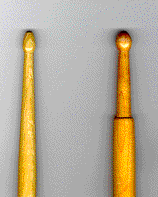
The stick on the left has a normal design, the stick on the right is Tom Gauger's model #17.
The abrupt change give the stick a special feel and balance because the fulcrum point is now closer to the butt end.
The Shape of the tip
For the tip I consider three base-shapes to be in existence:- Round shape (Ball, Apple)
- Oval shape (Pear)
- Triangle shape (Pyramid)
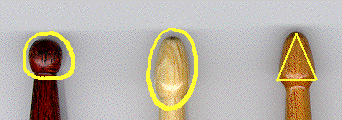
Almost all tips fall into one of those three base-shapes.
The shape of the tip is of major importance on the sound of the stick, when played on cymbals.
The influence of the weight on the sound
The weight of a stick is of course dependent on its size and the density of the wood. Given that, acoustical laws dictate that the heavier the stick (up to some obvious limit which is controlled by the size of the instrument), the fuller the sound you get. By full I mean that the whole sound spectrum from low to high frequency comes out.
This is something that best can be heard by heaving someone else play your drum, while you are some 20 feet away. No miking! Just the drum, the sticks and the player. Of course the drum itself is of (major) importance, but given a good drum, the sound when played fortissimo with light sticks, is terrible, no matter how hard you hit! Playing softly with heavier sticks also gives a much richer and defined sound.
Give it a try. Of course when you are playing on a miked drum, then the most important factor is your sound-engineer!!
The sound of a heavy stick on a cymbal has also much more lower frequencies than a lighter stick. This is something that is not always wanted, but can be controlled to a certain degree by the shape and position of the tip.
The influence of the shape of the tip on the sound
Acoustical laws tell us that the smaller the point of contact the more higher frequencies are produced. The same is true for the density of the stick. The harder the wood (more dense), the higher the frequencies in the sound heard.
The ideal stick (in my opinion) is heavy, made of wood with a high density and the tip shape should be triangular: The weight gives me body, and the density - together with the Triangular tip- give me a clear cymbal sound.
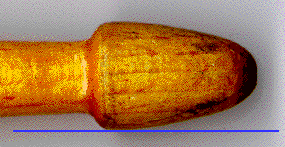
The Triangular tip (picture left). Here we have the smallest point of contact, hence the more higher frequencies come out and give a distinct and clear sound.
Because all the forces act on a very small point, stick wear is high! This can be avoided (somewhat) by selecting wood types with a high density.
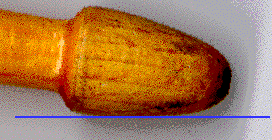
Now we have changed the position of the stick in such a way that the side of the triangle is in full contact with the cymbal. The sound changes from clear to dull! (picture right)
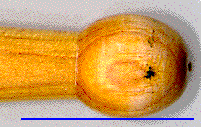
The stick with the ball-type of head has always the same area of contact. Changing its position doesn't have much effect. (picture left)
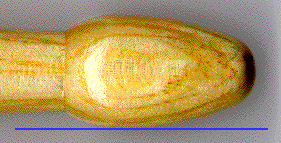
picture right: The Oval tip has a larger point of contact than the model above and hence a darker sound (when made of the same wood). Compared to the triangular tip its sound is darker than the triangular tip in the first position, but lighter than that stick in its second (flat) position.
Pair Matching
Good factories try to match their sticks into equal pairs. Equal of weight that is. But because factors like temperature and humidity have great influence on wood, it's always a good idea to try to match the pairs yourself before buying. Sticks are also suspect to warping and this can be checked by rolling them on a glass (or other flat) surface.
The Numbers on the Sticks
Most manufacturers put some kind of code on their sticks like: 5A, 7b, 6a or 3B, but because the manufacturers failed to come up with a system that would give us some real information about their sticks, the meaning of those numbers is without any use for comparing sticks of different manufacturers.
However, within the numbering of a given company you'll might find some system and you can be assured that a given number won't change its meaning.
Apart from numbers you'll see lots of other descriptions like "John Doe Jazz Model", "Dolly Parton Swing Model", "Band", "General", "Bolero", "Steve Gadd" and a thousand others, which mean just as much as nothing!
Read reactions from visitors below.
Go out to find the stick(s) you like best and buy them by the dozen, and if you're a real drum banger, buy them by the ton!
Reactions from Visitors
Benjamin vdenton3@cox.netIn reference to the several comments on Easton sticks, I have to say I can't stand the idea of an alloy stick with a removable sleeve and a screw-on tip. Doesn't sound natural to me. I think I would prefer a solid type stick made of polymer or other material, like the carbostick from europe which is made from carbon fiber and designed to replicate the feel and response of wood. The USA distributor of these sticks is HSS/Hohner. In general though, I still prefer high-quality wood sticks made of heavy hickory or oak. I have to agree that heavier denser wood sticks sound better on drums, especially if the stick is balanced forward. I've tried various non-wood sticks over the years and been disappointed with most of them, that's why I still favor using wood sticks, especially those that employ technology designed to ensure optimal consistency, grain stability, durability and integrity.Jennifer (jengirl30_98@yahoo.com)
I also think heavier sticks are the better choice. I use the Zildjian John Otto Artist Series drumsticks, whereas before I used to use Zildjian 7A's, which are very light sticks. Last night I played my first gig with the John Otto's, and I was totally and completely blown away by the way i sounded and the way felt playing with them. I have to admit, my arms are a tad sore, but it's a pleasant sore. All my musician friends also commented on the fact that I played and sounded better, and I told them it was because of the sticks.Michael Speichts (mspeichts@sangacorp.com) wrote me:
I am right-handed, play right-handed and have a rather interesting technique I use for drumstick choice. Since I am right-handed, I place a heavier stick in my right hand and a lighter, different style, stick in my left hand. It adds a lot of variety to the sound you can get out of each piece of your kit. Most noticeable is the distinct sound from cymbals when struck with two different weight-style sticks.Brett Watt (brettwatt@hotmail.com):
I use AHEAD drumsticks by Easton. They are artificial drumsticks made of a hollow aluminum shaft covered by a replaceable nylon sleeve, and a replaceable nylon screw-on tip. The handle is filled with some sort of shock absorbing material.Danny (secondchance26@aol.com) replied to the message above:
I find that they stand up to a lot of playing, and last a LOT longer than wood sticks (if taken care of properly). The cost is about 10 times what you normally pay for wood sticks, but they far outlast wood sticks in heavy applications (which is what I play in).
I played on the Ahead drumsticks as well. Probably the most accurately balanced sticks i've played on. But that is all the Ahead sticks have going for them. They are fragile and they bend rather easily. Also, I noticed the screw on nylon tips come loose after a while which means you have to constantly tighten them again. After a few rim shots, the sticks will bend, and eventually break. And at 30-40 dollars a pair, I cannot see the cost/benefit factor there. If I break a pair of wooden sticks, I grab another out of my stick bag and I dont think twice about it.Ernie Womack (ernie@brandxsavior.com) replied to the same message:
Jonas Torp Torp@mdb.ku.dk:While I agree with the above comment that Easton "Ahead" drumsticks bend somewhat easily, I still have to say that I am far more impressed with them than ANY wood stick I have ever played. If you reach into a case of Easton sticks and pull out any two sticks, they are going to be perfectly matched, you can't say that about any brand or model of wood sticks. Also, because Easton sticks are made to be shock absorbent, you will not have to deal with many of the long term affects that drumming can incur, such as Carpel Tunnel Syndrome, Tendonitis, Ect. I know that if I play with wood sticks for an hour my hands will be worn out and possibly cramped because of the repetitive vibration and impact, whereas if I played a hour with Easton sticks, I would not have to deal with those problems.
Looking at the aspect of cost, I will agree that the price you pay for Eastons is stifling when compared to the cost of other sticks, but if you know how to handle them in a way that they won't bend, they will last you for a long enough time that they will be more cost effective than wood sticks. I have pairs of Eastons that are still in perfect condition (I change the sleeves after about 5 hours of playtime) and they have lasted me for months. But any time I play ANY brand of wood sticks, they NEVER last me more than and hour or two. In my 16 years of playing I have played many different brands and models, and I have never found a stick that is more trustworthy, comfortable, and cost effective as Easton.
As a side note, the Easton model that I normally play is the Lars Ulrich model (I scratch his name off the sticks so as not to be confused as one of his fans). I have done a bit of research on the different models that they make, and not only is the Lars stick very close to being a 5B (when compared to Zildjian sticks, and Promark sticks) which is the size that is most comfortable in my hand, but they also have the thickest inner wall, which makes them also the strongest and least likely to bend/break when compared to other Easton models.
Another thing that influences the feel of the stick is the diameter of the shoulder compared to the dianmeter of the stick. I play a Vic Firth SD10 that's got quite a thick body that tapers off to a relatively thin shoulder. I find that this gives the stick more "bounce" than a normally configured stick of the same weight - this makes it a lot easier to play extremely fast jazz tunes, for instance...Jeff Rich customdrumsticks@hotmail.com
The numbers and letters on the sticks were first used for inventory purposes by Ludwig which first mass produced sticks in 1917, using a machine called a V10 Rotary knife made by a company called Goodspeed. 7A meant number 7 "All Purpose" and 2B meant number 2 "Band", 3S meant number 3 "Snare". Not very useful nowadays 'cept as somewhat of a vague reference point.